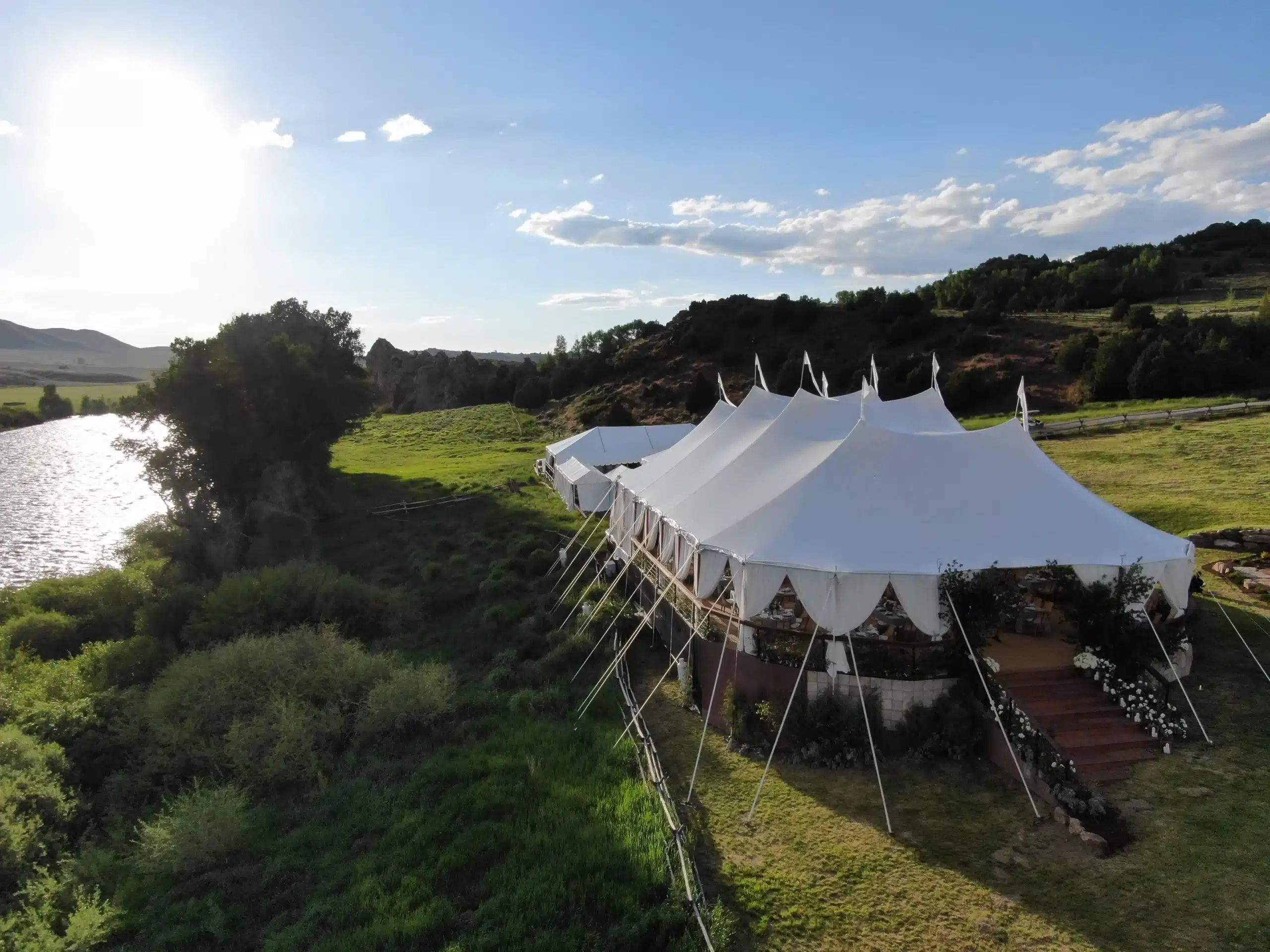Outdoor event planners face growing challenges as severe weather and unpredictable climates become more common—yet Skyline Tent Company, an award-winning provider of sailcloth, Navitrac, Frame, Century Pole, and Losberger Structure tents, has proven solutions for resilient outdoor venues. Sailcloth tents blend elegant design with engineered strength, but understanding their true capabilities under wind and rain is essential. This guide delves into the materials, pole structures, and installation techniques that give sailcloth tents their resilience, while highlighting limitations and comparisons to other shelter options. Armed with this knowledge, organizers can choose and secure the right tent for any weather scenario.
Key Takeaways
- Sailcloth tents feature high-tenacity fabric and reinforced construction for enhanced durability.
- Specialized pole geometries and tension systems help maintain stability in gusty winds.
- Water-repellent coatings and aerodynamic canopy shapes improve performance in heavy rain.
- Correct anchoring and professional setup greatly increase resistance to storms.
- Even robust sailcloth systems have limits, so backup plans are vital for extreme weather.
Understanding Sailcloth Tent Design for Weather Endurance

Sailcloth tents use high-strength fabrics that flex under load rather than tear, balancing tension evenly to resist wind and rain. Reinforced seams and protective coatings minimize water absorption and UV damage. The canopy’s tensioned layout channels water away, reducing fabric stress during downpours. Tensioned poles distribute wind loads, while strategic panel shapes prevent flutter. Together, these features form a resilient shelter against changing climates.
Core Features Making Sailcloth Tents Robust Against Elements
Manufacturers layer treated, high-denier textiles and double-stitch stress points to enhance durability. Canopy panels are cut to encourage rapid water runoff, and coated fibers repel moisture. Reinforced attachment points distribute tension evenly. Seams are sealed to prevent leaks. These combined measures let sailcloth tents stand up to severe conditions without compromising appearance.
How Sailcloth Material Withstands Wind and Rain Pressure
The sailcloth fabric’s woven structure disperses tension across the surface to avoid weak points during storms. Its waterproof coatings repel rainfall and prevent absorption, eliminating sagging from water weight. When wind strikes, the fabric flexes instead of breaking, adapting to gusts. This gives sailcloth a clear advantage over non-flexible materials. Strategic seam placement reduces vulnerability to leaks. These performance traits are especially useful during coastal or elevated terrain events. A weather-tested material helps ensure uninterrupted celebrations.
The Significance of Pole Structure in Maintaining Stability During Storms
Tent pole design plays a major role in stability during wind events. Sturdy aluminum or fiberglass poles, supported by tension lines, distribute force evenly. Cross-bracing adds extra rigidity, allowing poles to resist collapse during sudden gusts. The use of durable connectors and base plates ensures secure grounding. This structure minimizes swaying and protects the tent’s form. Proper alignment and anchoring of poles are vital during unpredictable conditions. Tents that maintain frame integrity reduce safety risks during storms.
Aerodynamic Qualities of Sailcloth Canopies in Windy Conditions
The canopy’s curved design promotes aerodynamic flow and reduces drag from strong wind bursts. Unlike flat structures that trap air, the sailcloth tent shape directs wind over and around the surface. This minimizes uplift and sideloads that can distort or shift the structure. Reduced turbulence helps preserve internal comfort and air circulation. Combined with tensioned fabric, this aerodynamic approach maintains structural integrity. A streamlined profile is essential for event tents exposed to shifting weather. This design also enhances the aesthetic value of the venue.
Assessing Sailcloth Tent Performance in High Winds and Gusts

Sailcloth tents demonstrate reliable performance in windy conditions when proper installation and anchoring techniques are employed. Their flexible fabric and tensioned design allow them to absorb and redistribute wind loads rather than resist them rigidly. Performance depends on canopy quality, frame strength, and staking methods. Even top-quality sailcloth systems have limits under sustained high winds. Understanding these dynamics helps event planners optimize setup for safety and comfort.
Typical Wind Resistance Capabilities of Sailcloth Structures
Most premium sailcloth tents can withstand wind gusts up to approximately 40–50 mph when correctly installed. The fabric’s tensioned form helps prevent flapping, while pole flex absorbs sudden forces. Reinforced seam lines and sturdy connectors reduce failure points. Proper guy-line placement and corner anchoring are critical. Exceeding these wind speeds without additional reinforcement can risk structural damage. Always verify wind ratings with your tent provider before use.
Factors Influencing Sailcloth Tent Steadfastness in Windy Events
Key variables include canopy tension, frame geometry, and ground conditions. Higher tension improves shape retention but must be balanced to avoid fabric tearing. Robust pole configurations with cross-bracing enhance rigidity. Loose or uneven ground demands longer or heavier stakes. Environmental obstacles—trees, buildings, slopes—can create turbulent eddies. Careful site assessment and tailored anchoring mitigate these risks. Optimal steadfastness requires aligning all these factors.
Securing Sailcloth Tents Effectively for Optimal Wind Resilience
Are Sailcloth Tents Suitable for Rainy and Stormy Weather Conditions?

Sailcloth tents excel at shedding water quickly thanks to their coated, tightly woven fabric and sloped canopy designs. Their hydrostatic head ratings typically exceed 1000 mm, preventing short-term leaks under heavy downpours. Reinforced drainage channels guide runoff away from occupancy areas. However, sustained rain combined with strong winds places additional stress on seams and frame connections. Professional installation and regular maintenance help ensure the tent stays watertight throughout extended wet conditions.
Water Resistance Levels of Sailcloth Fabric During Downpours
Premium sailcloth features a durable waterproof coating that repels moisture rather than absorbing it. The fabric’s high hydrostatic head rating means it resists significant water pressure before leaking. This quick-shed behavior prevents sagging and pooling. Regular reapplication of a compatible water-repellent treatment maintains performance. Consistent inspection of seams and coatings ensures the canopy remains impermeable in intense rain.
Managing Water Runoff and Preventing Puddling With Sailcloth Tents
Canopy pitches are designed to encourage rapid water flow toward integrated gutters or ground perimeters. Proper tensioning avoids low points where water can collect. Installing drainage channels or ground-level trenches further directs runoff away. Checking that seams remain sealed and that tension lines are adjusted after rain ensures continuous drainage. Avoiding flat sections on the canopy edge eliminates puddle formation, preserving fabric health.
Sailcloth Tent Integrity During Prolonged Stormy Weather Events
Extended exposure to wind-driven rain tests both the canopy and its supporting structure. Strong frames with cross-bracing resist deformation under sustained loads. Frequent checks during long events help identify emerging leaks or loose fittings. Addressing minor seal failures promptly prevents larger breaches. While sailcloth tents perform well in multi-hour storms, very long exposures demand contingency measures such as additional reinforcement or intermittent inspections.
Comparing Sailcloth Tent Storm Performance to Other Event Shelters
Compared to vinyl or canvas alternatives, sailcloth tents combine lightweight portability with robust water resistance. Canvas may absorb moisture, becoming heavy and prone to sagging, while vinyl can become brittle in cold. Sailcloth strikes a balance, offering flexible response to wind and rain. Rigid structures like metal pavilions provide greater permanence but lack sailcloth’s quick-setup benefit. Selecting the right shelter depends on event duration and expected severity.
Essential Anchoring and Installation for Weathering Stormy Events

Proper anchoring and expert installation form the backbone of storm-ready sailcloth setups. Stakes, guy lines, and tensioners must be selected and placed according to ground conditions and wind forecasts. Tension adjustments distribute loads evenly across the canopy. Anchoring at precise angles maximizes resistance to uplift and shear forces. A meticulous installation process transforms a sailcloth canopy into a safe, resilient shelter.
Correct Staking Methods for Sailcloth Tents in Unpredictable Weather
Use heavy-duty stakes driven at a 45° angle away from the tent to combat uplift. Place stakes at all corners and midpoints, connecting them with high-tension guy lines. For soft soil, longer stakes or auger anchors improve holding power. Periodically check and retighten tensioners to account for ground settling. Secure tension distributes wind loads effectively, preventing anchor pullouts during gusts.
The Role of Professional Setup in Ensuring Tent Safety During Storms
Engaging experienced installers ensures every component is correctly aligned and tensioned. Professionals account for local terrain and wind patterns, optimizing anchor locations and line angles. They use calibrated tensioning tools to achieve uniform canopy tautness. Pre-storm inspections by trained crews identify weaknesses before they become failures. A professionally executed setup significantly reduces weather-related risks.
Choosing an Optimal Site to Bolster Sailcloth Tent Resilience
Select a level, well-drained site away from natural hazards like flood zones or rock outcroppings. Natural windbreaks—such as hedges or buildings—can reduce exposure to direct gusts. Ensure clear space above the canopy, avoiding overhead branches that might fall. Adequate ground firmness supports stake anchoring. Thorough site evaluation minimizes environmental stressors and enhances shelter stability.
Pre-Event Checks for Sailcloth Tent Security in Anticipation of Storms
Before forecasted storms, conduct a comprehensive walk-around: verify canopy tension, inspect all stakes and lines, and tighten hardware as needed. Confirm that drainage paths are clear of debris. Check pole connections for corrosion or looseness. Review anchor embedment depths and adjust if soil conditions have shifted. Document and address any issues immediately to maintain readiness for severe weather.
Limitations When Using Sailcloth Tents in Severe Weather Scenarios

While sailcloth tents offer impressive resilience, they have defined operational limits. Sustained winds beyond 50 mph or continuous, heavy rain may exceed design tolerances. Rapid weather changes like microbursts and hailstorms can inflict damage despite robust construction. Recognizing these thresholds is critical for safety planning. Event organizers must balance aesthetic benefits with realistic performance constraints under extreme conditions.
Identifying Conditions Where Sailcloth Tents May Not Be Adequate
Strong gusts consistently above design ratings risk canopy tearing or anchor failure. Combine this with torrential rainfall, and seams may begin to leak. Lightning exposure adds another hazard, necessitating evacuation. Rapid thermal shifts can also loosen tension lines. Understanding these scenarios helps event planners decide when sailcloth tents should be supplemented or replaced with more rigid structures.
Wind Speed Thresholds for Safe Sailcloth Tent Usage
Design wind ratings typically fall between 40–50 mph under optimal anchoring and canopy tension. Exceeding this range even briefly can cause fabric stress and hardware fatigue. Always consult the tent’s specifications and local wind forecasts. In gust-prone regions, consider temporary reinforcements or alternative shelters. Adhering to these thresholds prevents structural compromise and ensures guest safety.
Potential Risks to Sailcloth Tents During Extreme Stormy Events
Hazards include fabric tearing from sustained oscillations, pole buckling under lateral loads, and anchor pullouts that allow uncontrolled uplift. Water pooling can weigh down canopies, leading to seam failures. Collapsing sections pose serious risks to occupants. Proper risk assessment and immediate response protocols are essential to mitigate these dangers. Recognizing early warning signs preserves both equipment and people.
Safety Measures for Guests if Storms Threaten a Sailcloth Tent Setup
Establish clear evacuation routes and designate nearby reinforced shelters. Develop a communication plan using weather alert systems or two-way radios. Train staff to guide guests calmly and efficiently to safety. Keep emergency kits with blankets, lighting, and first-aid supplies readily accessible. Regular safety drills ensure everyone understands procedures before a crisis arises.
Frequently Asked Questions
How does the design of sailcloth tents enhance their durability?
Skyline Tent Company’s sailcloth systems incorporate high-tenacity woven fabric, reinforced seams at all stress points, and water-repellent coatings. Their aerodynamic canopy shapes and tension-based designs distribute wind and rain loads evenly, preventing localized fabric fatigue and extending tent life.
What wind speeds can a quality sailcloth tent typically handle?
When installed by Skyline’s professional crews with correct anchoring and tensioning, most sailcloth tents safely resist gusts up to around 50 mph. Premium models with extra reinforcements can tolerate slightly higher speeds, provided all guy lines and stakes are properly secured.
Are sailcloth tents suitable for prolonged heavy rains and storms?
Skyline’s sailcloth tents feature robust water-repellent coatings and canopy pitches designed for rapid runoff. They perform well in sustained rain, but extended storms combined with high winds require expert anchoring and regular inspections to maintain watertight integrity.
What safety measures should be in place if extreme weather strikes during an event?
Ensure all anchors, guy lines, and tensioners are professionally installed and checked; establish clear evacuation routes and monitor weather alerts; and have prearranged alternative shelter options ready to protect guests.
When should an organizer consider alternative tents over sailcloth tents?
If weather forecasts predict conditions beyond the tent’s rated performance—such as prolonged high winds or severe storms—opting for a more rigid shelter system (e.g., heavy-duty frame or modular tents) may be necessary to ensure maximum safety.
Conclusion
Sailcloth tents offer a compelling balance of beauty and weather performance, thanks to their advanced fabrics and structural designs. Proper material care, expert installation, and secure anchoring enable them to withstand most wind and rain scenarios. However, recognizing their operational limits and having contingency shelters ensures event success and guest safety when nature’s worst strikes.

